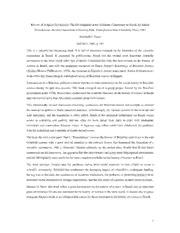
A Space for Science - Book Review (Marshall Eakin, ISIS) PDF
Preview A Space for Science - Book Review (Marshall Eakin, ISIS)
Review of A Space For Science: The Development of the Scientific Community in Brazil, by Simon Schwartzman. Revised translation. University Park: Pennsylvania State University Press, 1991 Marshall C. Eakin ISIS 84:1, 1993, p. 181 This is a valuable but frustrating book. It is full of important material on the formation of the scientific community in Brazil. If measured by publications, Brazil has the second most important scientific community in the third world (after that of India). Comparatively little has been written on the history of science in Brazil, and with the prominent exception of Nancy Stepan's Beginnings of Brazilian Science (Science History Publications, 1976), the literature in English is almost nonexistent. Simon Schwartzman's work offers the closest thing to a historical survey of Brazilian science in English. Schwartzman is a Brazilian political scientist who has written extensively on the social history of Brazilian science during the past two decades. This book emerged out of a group project funded by the Brazilian government in the 1970s. Researchers synthesized the available literature on the history of science in Brazil and interviewed more than fifty older scientists about their careers. This substantially revised translation effectively synthesizes the Brazilian edition and attempts to reorient the material to address a North American audience. Unfortunately, the various sections of the book are not well integrated, and the translation is often stilted. Much of the historical background on Brazil comes across as confusing and garbled, and too often the book jumps from topic to topic with inadequate transitions and connections between issues. A rigorous copy editor could have eliminated the problems with the translation and a number of simple factual errors. The book has two major parts. Part 1, "Foundations," surveys the history of Brazilian science up to the mid twentieth century with a great deal of attention to the external factors that hampered the formation of a scientific community. Part 2, "Growth," focuses primarily on the period since World War II and draws extensively on the interviews. An appendix lists the interviewees and gives some biographical information, and the bibliography must surely be the most complete available on the history of science in Brazil. The book provides insights into the problems facing third world countries in their efforts to create a scientific community. Schwartzman emphasizes the damaging legacy of colonialism, inadequate funding, the key role of the state, the weaknesses of academic institutions, the problems of promoting research in an industrial sector dominated by foreign corporations, and the low status of scientists in third world societies. Despite its flaws, this book offers a good introduction to the history of science in Brazil and an important point of reference for anyone interested in the history of science in the third world. It should take its place alongside Stepan's book as an indispensable source for those interested in the history of science in Brazil. 1
